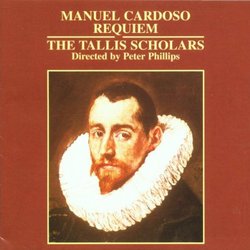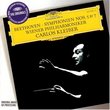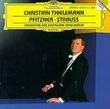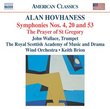| All Artists: Manuel Cardoso Title: Cardoso: Requiem Members Wishing: 0 Total Copies: 1 Label: Gimell UK Release Date: 2/12/2002 Album Type: Import Genre: Classical Styles: Opera & Classical Vocal, Historical Periods, Baroque (c.1600-1750), Early Music Number of Discs: 1 SwapaCD Credits: 1 UPC: 755138102125 |
Search - Manuel Cardoso :: Cardoso: Requiem
 | Manuel Cardoso Cardoso: Requiem Genre: Classical
![header=[] body=[This CD is available to be requested as disc only.]](/images/attributes/disc.png?v=15401716) ![header=[] body=[This CD is available to be requested with the disc and back insert.]](/images/attributes/disc_back.png?v=15401716) ![header=[] body=[This CD is available to be requested with the disc and front insert.]](/images/attributes/disc_front.png?v=15401716) ![header=[] body=[This CD is available to be requested with the disc, front and back inserts.]](/images/attributes/disc_front_back.png?v=15401716) |
Larger Image |
CD DetailsSimilarly Requested CDs
|
CD ReviewsA lovely Renaissance Mass Barbara J. Chaplin | Saskatoon, Saskatchewan Canada | 09/21/2002 (5 out of 5 stars) "I bought this cd because it received a starred review in the Penguin Guide to Classical Music on CD, and I have to say that the music certainly deserves that accolade. Cardoso is a Portuguese composer of the late Renaissance. This mass setting sounds more rythmically complex and less purely Renaissance than those of (the earlier) Palestrina. The sung phrases are very long, making the music sound ethereal and serene. The music is very beautiful, and also very calming. (I don't know about you, but one of the reasons I like to listen to Renaissance Masses is because they calm me down.) The quality of the singing is, as is usual with the Tallis Singers, first-rate, and the recording is also excellent. I have to thank the Tallis Singers and the Penguin Guide for introducing me to an unfamiliar composer! This cd truly is wonderful." Magnificent! FrKurt Messick | Bloomington, IN USA | 07/08/2004 (5 out of 5 stars) "--Frei Manuel Cardoso-- Cardoso was born about 1566 in Lisbon. Part of the Portuguese renaissance (only recently becoming a topic of major study), his musical influences seem to lag behind a bit the rest of Europe, but have strong staying power also. A member of a Carmelite order in Lisbon, Cardoso was musically trained for liturgical and choir music; he had the Portuguese King John IV as a patron, who (like the Emperor of Austria who was a patron of the arts during Mozart's time) had a fine appreciation for music, and was himself a performer and composer. Cardoso produced many masses, motets, and some other kinds of music; he was directly influenced by Palestrina, among others. He died in 1650--Motets and Magnificat-- Motets (in this sense) are choral settings of Latin religious texts, generally in four to six voiced parts, sometimes more. One motet, Mulier quae erat, is different from the other three (Non mortui, Sitivit anima mea, Nos autem gloriari) - similar to the Magnificat also included on the disc, the music begins in a enigmatic way, the listener not really certain where things are heading with regard to tonality, until this is resolved a few bars into the piece. Mulier quae erat and Nos autem gloriari were scored SAATB and Non mortui and Sitivit anima mea were scored SSATTB.--Requiem Mass-- This mass follows a six-part arrangement, SSAATB, with the closing Libera me scored for four voices, SATB. There are suggestions of baroque experimentation here (much of Cardoso's work was destroyed in the Lisbon earthquake of 1755, so we can't be sure how extensive this influence was overall on Cardoso). Most requiems were written for specific persons; we do not know for whom this one was composed. --Liner Notes-- Being internationally acclaimed, the Tallis Scholars' CDs typically present their commentary and texts in English, French, German and Italian (together with any Latin texts, including the text of the mass); that is true of this disc. The cover art also typically represents visual arts contemporary with the compositions - here it is a piece by El Greco, `Portrait of a Gentleman' from the Museo del Prado, Madrid. --The Tallis Scholars-- The Tallis Scholars, a favourite group of mine since the first time I heard them decades ago, are a group dedicated to the performance and preservation of the best of this type of music. A choral group of exceptional ability, I have been privileged to see them many times in public, and at almost every performance, their singing seems almost like a spiritual epiphany for me, one that defies explanation in words. Directed by Peter Phillips, the group consists of a small number of male and female singers who have trained themselves well to their task. Their recordings are of a consistent quality that deserve more than five stars; this particular disc of pieces by Cardoso deserves a place on the shelf of anyone who loves choral music, liturgical music or Gregorian chant, classical music generally, or religious music. It is astonishing. The music on this disc was originally recorded in 1990 at the Church of Sts. Peter and Paul, Norfolk, one of their favourite recording sites." Cardoso Requiem Valerie Smith | Bloomington, IL | 03/18/2006 (5 out of 5 stars) "The Manuel Cardoso Requiem has been one of my favorite pieces since I discovered the Tallis Scholars fifteen years ago. I had a tape version of it that I lost and I missed it enough to replace it. This piece has amazing melody lines and haunting harmonies, and the Tallis Scholars are easily the best performers in this genre."
|

 Track Listings (13) - Disc #1
Track Listings (13) - Disc #1








